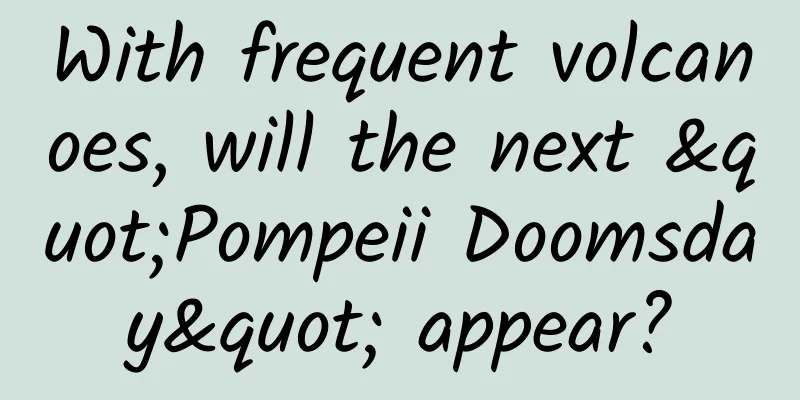With frequent volcanoes, will the next "Pompeii Doomsday" appear?

|
About two thousand years ago, on an afternoon of August 24, 79 AD, the once vibrant ancient city of Pompeii was frozen in time forever. Source: Documentary "Pompeii: The Dust Settles" The culprit of this tragedy was the eruption of Mount Vesuvius. That day, the surging volcanic ash and lava flooded Pompeii like a flood, and everything was destroyed. Volcanic eruptions are actually nothing new. Not long ago, three volcanoes on the Aleutian Islands in Alaska, USA, erupted simultaneously, causing panic among people. It is rare for three volcanoes to erupt simultaneously. On August 16, Mount Merapi in Magelang, Indonesia, also erupted, with volcanic ash everywhere. On the 19th, Fagradalsfjordals volcano in Iceland also erupted. Volcanic activity around the world appears to be increasing. Why do volcanoes erupt? What types are there? 01 Terrifying and fascinating The magical nature has created a large number of unique geological structures with its uncanny craftsmanship, and volcanoes may be one of the most terrifying yet fascinating ones. When it is quiet, it seems just like a majestic mountain; but when it erupts, as the earth's crust breaks, hot magma, volcanic ash and gas as high as 1400 ° C burst out from the magma chamber below the surface, creating a hellish scene that is dangerous and deadly. An active volcanic crater in Vanuatu | Sam Cossman Image source: huffpost.com 02 Types of volcanoes Volcanoes around the world have different looks and personalities. Most people divide them into three types based on their activity: An extinct volcano that almost never erupts Active volcanoes that are still active and erupt frequently or are expected to erupt A dormant volcano that has erupted in history but has remained relatively dormant for a long time. However, the differences between volcanoes go far beyond this. Even the ways of eruption are different, which is far from the scene of "magma rushing into the sky like giant fireworks" as people imagine or see in cartoons. Conventional impression of volcanic eruption scenes Image source: tenor.com 03 Types of outbreaks Most types of volcanic eruptions are named after a volcano. This is because scientists often observe a certain eruption phenomenon from the most famous volcanoes, and thus most of them are named after them. Hawaiian Eruption This type of volcanic eruption is represented by the volcanoes on the island of Hawaii. It is characterized by rarely occurring violent explosions and is the calmest type of volcanic eruption activity. The low-viscosity basalt magma overflows from the crater on the top of the mountain or the cracks on the mountainside, flowing slowly downward. The inspiration for the chocolate lava cake came from this. This type of eruption is unlikely to cause casualties, and most deaths are the result of people forcing themselves to get close enough to take photos. However, the flowing magma will destroy surrounding farmland and villages, causing certain property losses. December 20, 2020 Eruption of Kilauea volcano in Hawaii Image source: weather.com Stromboli eruption This type of eruption is represented by the Stromboli volcano on the Aeolian island of Sicily, Italy. Scoria, pebbles and volcanic bombs are continuously ejected to a height of tens to hundreds of meters, and then a large amount of pyroclastic debris falls back into the crater and is ejected again. A spectacular Stromboli-style eruption Photographed from Fogo Volcano in Cape Verde, West Africa Image source: scitechdaily.com This is also a relatively mild eruption, but the magma is relatively viscous compared to the Hawaiian eruption. Because the volcanic channel is not affected by the eruptive activity, the eruption system can constantly reset itself, allowing the Strombolian eruption to continue rhythmically for a long time, which is really like a continuous eruption of fireworks. In addition, due to the persistence of such small-scale eruptions, Stromboli has been called the "Lighthouse of the Mediterranean". Vulcano eruption This type of eruption is named after the island of Vulcano near Sicily, Italy. When a volcano erupts in this way, a thick, consolidated crust forms on the crater, under which gases accumulate. Therefore, when an eruption occurs, dense eruption clouds containing volcanic ash rise from the top of the volcano. These "cauliflower-shaped" eruption clouds are usually dirty gray-black. Vulcano eruption of Mount Taurus in Papua New Guinea Image source: wiki In a Vulcano eruption, the gases can reach supersonic speeds, creating a shock wave, so this eruption is very noisy. Although it is stronger than a Stromboli eruption, in most cases it is still a bluff and not very harmful. But we cannot be completely careless, because Vulcano eruptions will produce a large number of "crust-like volcanic bombs". If you are too close to the volcano during the eruption, it is very dangerous to be hit by the solidified lava from these hard rocks. Bread crust volcanic bomb Image source: wiki Peleian Eruption This type of eruption is named after Mount Pelée, a volcano on the French Caribbean island of Martinique. The 1902 eruption of Mount Pelée was one of the worst natural disasters in history, causing massive destruction and killing more than 30,000 people. A Peléan eruption is a violent volcanic eruption that produces high-viscosity magma. Its characteristic feature is a pyroclastic flow consisting of fast-moving hot gases, ash and pyroclastics that flows down the slope. In the 1902 eruption, pyroclastic flows with temperatures exceeding 1075°C covered the entire city of Saint-Pierre within a minute, instantly igniting all combustible materials. This was the first time that human scientists became aware of the natural phenomenon of pyroclastic flows. Image source: he-earth-story.com Plinian Eruption Sometimes called a Vesuvian eruption, the eruption of Mount Vesuvius in 79 AD was a typical Plinian eruption that destroyed the city of Pompeii, 13 kilometers from the crater. The eruption was named after the Roman historian Pliny the Younger, who witnessed it and compared the various types of volcanic eruptions. The most obvious feature of a Plinian eruption is the towering eruption column. Volcanic ash and pumice can be ejected into the stratosphere more than 10 kilometers above the ground and pushed away from the volcano by the wind. These solid materials eventually fell to the ground, and the entire city of Pompeii was buried by an average 7-meter-thick layer of pumice. The Plinian eruption of Redoubt in 1990 Image source: wiki Plinian eruptions are the most powerful type of volcanic eruption known to date, often forming calderas with collapsed cone tops. A caldera in the Ecuadorian Andes Image source: nationalgeographic.org | Photographer: OBLIOT Surtseian eruption This is a type of eruption caused by a special landform. From 1963 to 1967, a volcanic crater on the shallow seabed in southern Iceland erupted repeatedly, eventually forming a new volcanic island - Surtsey. Surtsey eruptions are characterized by repeated explosive eruptions. When hot basaltic magma comes into contact with cold seawater, the temperature difference between the two causes a violent "water-lava" interaction, driving the explosion. The eruption of Surtsey on August 19, 1966 Image source: volcanocafe.wordpress.com However, these main types of volcanic eruptions are not complete, because they do not mean that volcanoes will not experience other types of eruptions. In fact, people have always maintained their love and awe for nature, and are still observing volcanic activity to try to understand it better and avoid the next "Pompeii Doomsday". References [1] Becker, Robert John and Becker, Barbara (1998). "Volcanoes", p.133 [2] Scarth, Alwyn. La Catastrophe. Oxford. 2002: 207." [3] How Volcanoes Work: Sakurajima Volcano". San Diego State University. [OL]. (http://sci.sdsu.edu/how_volcanoes_work/) [4] Surtsey – The Birth of the Modern World, 2013 Nov.[OL]. (https://volcanocafe.wordpress.com/2013/11/13/surtsey-the-birth-of-the-modern-world/) [5] Stephanie Pappas, Deadly Volcanic Flows Glide on Their Own Cushion of Air [OL]. (https://www.scientificamerican.com/article/deadly-volcanic-flows-glide-on-their-own-cushion-of-air/) Author: Wan San Editor: One person Acknowledgements: Ma Zhifei, senior engineer of geological exploration, provided scientific guidance for this article Source: Shanghai Science and Technology Museum — END — The copyright of the online pictures belongs to the original author The article is owned by Shanghai Science and Technology Museum Reproduction without permission is prohibited |
Recommend
How can this "cheap" metal support the industrial backbone of our motherland?
1. The metal with the largest production and usag...
A large neck, is it because you are fat or sick?
Nowadays, girls are paying more and more attentio...
Want to lower house prices? It might be a good idea to teach cars to drive themselves
Who would have thought that the group of people w...
8 years after Steve Jobs' death, is Tim Cook a qualified Apple CEO?
October 5, 2019, coincided with the 70th annivers...
New discovery! New time limit of Yanliao Biota: a legend of life spanning tens of millions of years
Produced by: Science Popularization China Author:...
Samsung admits S8 rear fingerprint sensor is bad, recommends users not to use it
Samsung officially released this year's flagsh...
A super detailed guide to operating Tik Tok!
Here I come, bro! 5G mobile phones will be releas...
Advertising material production process
How to design a good set of materials quickly and...
Great Wall Motors "bets" on the World Cup, and its two major brands may benefit from it
For WEY, a high-end brand under Great Wall Motors...
mv Weimiao Business School Advanced Financial Management Course Index Fund Stock Course
I believe many friends have seen the advertisemen...
LeEco's second largest shareholder: The turning point lies in Mr. Jia's one thought
1-minute speed reading tips 1. “LeEco’s ecologica...
iOS Native and JavaScript Interaction
When it comes to the interaction between Native a...
Cao Yu Fitness Training System Baidu Cloud Download
Cao Yu Fitness Training System Resource Introduct...
"Light" talk about the design concept of H5 mini games
I. Introduction Since my main job recently is to ...
Didi Game Center - A "beautiful mistake"
I believe everyone already knows: Didi issued an ...









